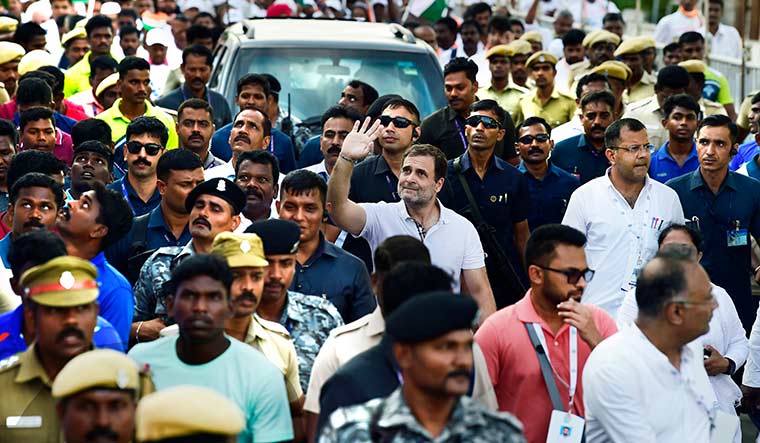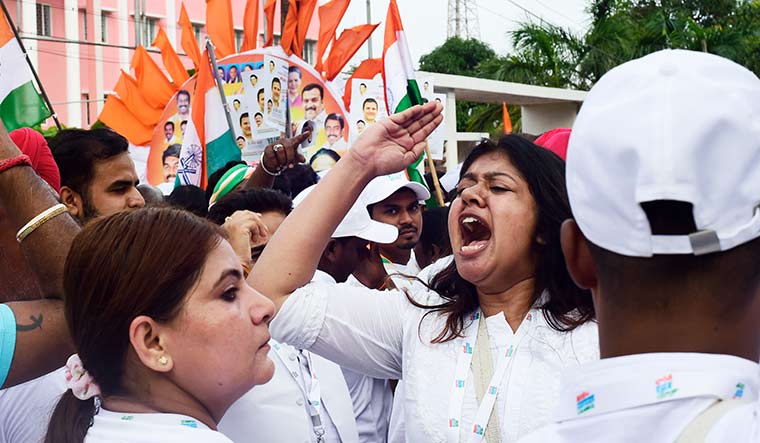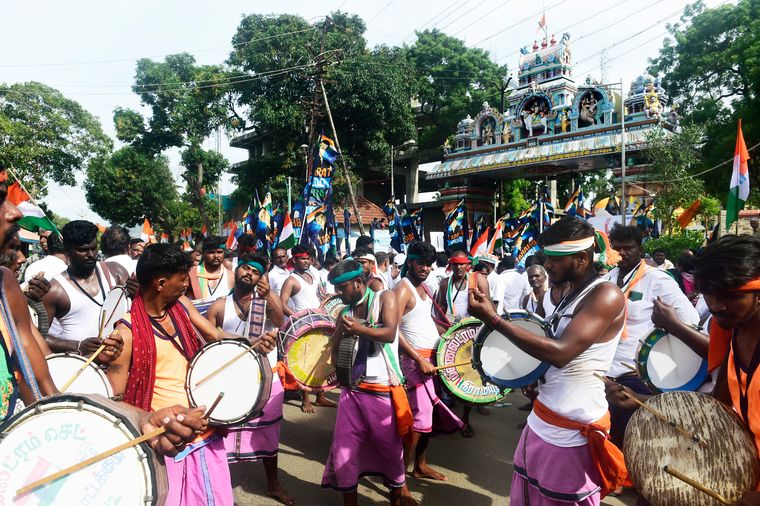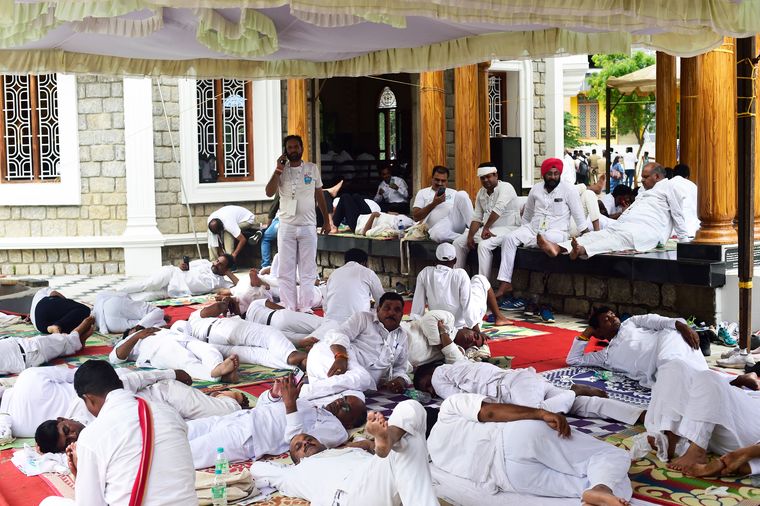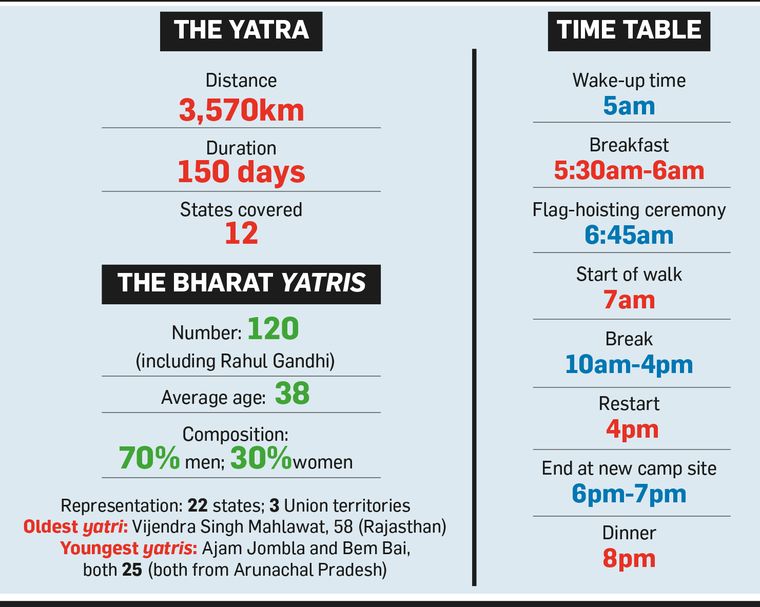Blisters on his feet, Youth Congress leader Satyam Thakur trails the Bharat Jodo Yatra contingent as it passes through Thiruvananthapuram. The 31-year-old said bringing up the rear of the yatra had its advantages. He can witness the enthusiasm of the people who have turned up to see the yatra sustain long after the vanguard has passed by.
What drives Thakur, district president of the Youth Congress in Palghar, Maharashtra, is the adrenaline rush of being a part of what is touted as the longest padyatra ever attempted in Indian politics. He has been to a hospital en route to get his feet bandaged, and revealed that the hospital authorities refused to accept any payment from him since he is a Bharat yatri. “Pain is a constant during the yatra. But there is also a feeling of pride and great responsibility,” he said.
“Since I am right at the back and half an hour behind the lead yatris, I can see that the people are waiting to cheer the last padyatri. The local residents are offering us coconut water, fruits and tea. Seeing that some of us are limping because of the sores on our feet, we are being offered rides till the next stop, which we, of course, have declined,” he said.
Thakur was a pilot in the US before he returned to his native village in Palghar and involved himself in public service. He said he had to be a part of the yatra since it was a once in a lifetime opportunity and that he wanted to be recognised for having walked with party leader Rahul Gandhi.
Thakur is among 118 Bharat yatris, who along with Rahul, have embarked on the 3,570km-long Kanyakumari to Kashmir yatra on September 8. Most of them are young; the average age of the group is 38. Women comprise 30 per cent of the group. Some of the yatris are known faces, such as former student leader Kanhaiya Kumar or Pawan Khera, chairman of media and publicity of the All India Congress Committee. Some are in prominent backstage roles, such as Sandeep Singh, who is a key aide to Priyanka Gandhi Vadra. However, a majority of the participants are lesser known members of the party.
“The josh is high,” said Samrat Keshari Jena, a 36-year-old Youth Congress leader and a municipal councillor from Kendrapara, Odisha. Jena could not care less that the phrase is closely associated with the ruling dispensation’s nationalistic claims. It was popularised by the movie Uri which was based on the surgical strikes across the border ordered by the Narendra Modi dispensation in 2016. For Jena, what is important is that it aptly describes the sentiment among the yatris and the response they have received so far.
“If you walk for even two or three days, you are bound to end up with body ache and blisters on your feet. But what is important is that I am getting to be a part of a historic yatra and I am walking with my leader,” Jena said. His family, however, feels that he will not last the entire distance and will return home soon. But Jena is sure that he is in for the long haul.
Ruby Khan, a 43-year-old leader from the minority department of the party in Rajasthan, called the sore spots on her feet “medals” that symbolised the struggle that she was a part of. “This is like another freedom struggle. We are fighting for our country under the leadership of another Gandhi,” said Khan, an activist and a writer.
The yatris, who are literally giving their blood and sweat to the cause, will be on the road for around five months, walking across 12 states, acting as ambassadors of the ambitious initiative and getting recognised as Rahul’s brigade. What is common among them regardless of their disparate backgrounds is their unqualified faith in Rahul as their leader. It must be noted that the Bharat yatris were carefully selected from around 600 candidates after an interview conducted by senior party leaders Digvijaya Singh and Mukul Wasnik.
Dressed in white, carrying a khadi bag provided by the party, in which there is a water bottle, an umbrella and a pair of T-shirts, the yatris display a youthful optimism which the party hopes will sustain the long walk. They are joined by party members from the host state and the states that the yatra will not pass through. Their energy is matched by the robust mobilisation of support drummed up by local party units in Tamil Nadu and Kerala. Together, all of this is helping build the right momentum for the march in its initial stages and the perfect aura for Rahul, who is in the lead even though he insists that he is only a participant.
“For us in the Congress, this is a journey, this is an attempt at understanding what is going on, on the ground in India, and an attempt at undoing some of the damage that the BJP and the RSS have done,” Rahul told reporters after embarking on the yatra. He further said that it was a “powerful thing to do from a political and also a personal standpoint”, and that a few months down the line, he expected himself to be “a little wiser”.
While it is true that Rahul has consistently been a voice opposed to the ideology of the BJP-RSS, the yatra holds far greater significance for him as a leader and for his beleaguered party.
The yatra has been undertaken at a time when the Congress is at its weakest and the leadership of the Gandhis, especially that of Rahul, is under question. Also, it is apparent that while the party has desisted from labelling it a Rahul show, it is indeed as much about finding a strong validation for his leadership as much as it is a desperate attempt to find an emotional connect between the Congress and the people. Yatras have been a regular occurrence in Indian politics, and many of them have resulted in electoral success for those who undertook them. And the Congress would be hoping that the Bharat Jodo Yatra would have a similar outcome.
The deliberations at the three-day Chintan Shivir of the Congress in Udaipur in May had culminated in the slogan ‘Bharat Jodo’. It was apparent that the call to unite India, inspired by noted Gandhian Subba Rao’s slogan, “Jodo, Jodo, Bharat Jodo”, was an effort to re-connect with the masses since it was unanimously concluded at the brainstorming session that the party had lost connect with the people at the grassroots.
The yatra, which was earlier scheduled to begin on October 2, aims at bringing under the umbrella of the call for a united India bread and butter issues such as inflation and unemployment, the aspirations of the youth, the concerns of women, the fears of the marginalised and the perception that the BJP-led Centre has compromised the neutrality of institutions and investigating agencies, and has disregarded the values of federalism.
If the youth brigade is powering the yatra, party veteran and Rajasthan Chief Minister Ashok Gehlot, old warhorse Digvijaya Singh, expert strategist Jairam Ramesh and Congress general secretary in charge of organisation K.C. Venugopal are among the seniors pitching in with their expertise. If Gehlot has provided the political firepower on the sidelines of the yatra, Digvijaya, with the experience of having undertaken a 3,300km-long Narmada Parikrama Yatra in 2017-18, is the yatra’s chief planner. Ramesh, who is Congress general secretary in charge of communications, has the challenge of making effective use of the media to amplify the impact of the yatra, while Venugopal has to ensure that the organisation shows up in full strength.
Rahul, who is extremely fit for his 52 years, has walked fast. According to a senior leader, he wanted to cover 25km a day, while the yatra has been averaging around 20km. Dressed mostly in a white T-shirt and beige or black track pants, switching to the white kurta-pyjama politician kit occasionally, and wearing vibrant blue shoes, Rahul has presented a picture of a determined yatri.
The party hopes that the enthusiastic response in the Congress stronghold Kanyakumari and then in Kerala, where the party’s organisation is strong, will help Rahul come across as a leader having a connect with the people. The Wayanad MP’s pit stops at coconut water stalls and tea shops, visuals of him walking hand in hand with kids who have rushed to meet him from their football training or comforting and offering water to an elderly woman admirer or his interactions with citizens’ groups portray him as an empathetic leader.
Congress leaders reject the idea that the yatra is an exercise aimed at rebranding Rahul. But the unstated expectation of the party is that it will help deal with the image problem that hounds Rahul, that he is inconsistent, does not see campaigns through and is absent when the party is dealing with a major political issue.
It is felt that if Rahul is on the road for the next five months and walks the entire course of the yatra, it will help him come across as a leader who is committed to the cause of the people. A key message being sought to be conveyed is that Rahul is not going anywhere.
“There is nothing wrong with focusing on the leader and the Gandhi family. What is wrong with talking about the family? The family has the highest credibility. It has held the party and the country together,” said S. Jothimani, MP from Karur, Tamil Nadu, about the BJP’s charge that the yatra was all about saving the Gandhi family.
The journey so far has been encouraging for the Congress, creating the right kind of energy before the yatra moves northwards. There is hope that the yatra will re-energise the organisation and provide party workers–demoralised by a series of electoral defeats–with a sense of purpose and direction. It is felt that if the leader is on the road, the party has to rise to the occasion and back him up.
“We are determined that the yatra will be a huge success. It will create a new political culture and will strengthen the party organisation,” said Ramesh. “India needs a strong, vibrant Congress. And the yatra is like sanjivani (a magical herb) for the Congress.”
After spending 18 days in Kerala, the yatra is scheduled to enter Karnataka on October 1. The Congress is involved in a direct fight with the BJP in Karnataka, which goes to the polls next year. The yatra will be in Karnataka for 21 days, the same duration that it will spend later in Rajasthan, another state which will have elections next year and where again the Congress’s main rival is the BJP.
The yatra is scheduled to be in Maharashtra and Madhya Pradesh for 16 days each, and in Telangana for 13 days. The journey through Haryana is expected to take around 12 days, while Punjab is allotted 11 days. It will be in Uttar Pradesh for five days and in Delhi for two days. It will end in Jammu and Kashmir sometime in February, and the party would want the culmination to take place in Srinagar, but is not very hopeful of getting the permission of the administration to do so.
The yatra route has been a topic of much debate. The ruling CPI(M) in Kerala criticised the Congress for giving only two days for Uttar Pradesh after spending 18 days in Kerala, and asked whether this was the way the Congress intended to take on the BJP-RSS. Even within the party, questions have been asked as to why Gujarat and Himachal Pradesh, which go to polls later this year, have been left out, and why a politically significant state like Bihar is not on the route.
Also read
- ‘Bharat Jodo Yatra taught me...’ Rahul Gandhi reminisces experience of movement that changed Congress's fate
- Bharat Jodo Nyay Yatra to begin on Sunday, focus on issues of social, political justice
- How Congress plans to celebrate the anniversary of Bharat Jodo Yatra
- Amid heavy snowfall, Bharat Jodo Yatra finale begins
- Five months, 4,000 km: Bharat Jodo Yatra to culminate in Srinagar today; rally planned
- Rahul denies rift in opposition as Bharat Jodo Yatra ends in Srinagar
The Congress said the yatra was always scheduled to be in Uttar Pradesh for five days and not two days, as claimed by the CPI(M). Party leaders insist that the route was not dictated by electoral considerations, and that it was not feasible to criss-cross the country and try and touch every state. Also, this particular route was chosen because it allowed for the journey to be made entirely on foot. Since it is a padyatra, other modes of travel cannot not be used. Chhattisgarh, which will also have assembly elections next year, was left out, said a party leader, because of the difficult terrain and also security considerations.
Meanwhile, the Congress realises that it will not be easy, not just because of the rigours of being on the road for five months and the logistical challenge, but also because Rahul will be closely watched by his critics both inside and outside the party and by people at large.
Political opponents, especially the BJP, will be closely following the yatris’ progress, especially that of Rahul, and be ready with their attacks. This makes it imperative for Congress managers to be on their toes as the yatris trudge along.
Already, the BJP has ensured that there is a controversy a day, raking up issues such as the price of Rahul’s T-shirt and shoes, claiming that he and his fellow yatris will sleep in luxurious containers, or raising questions about his interaction with a controversial Christian pastor.
Also, the unrest within the party is all too evident. There is a constant stream of leaders leaving the Congress. On September 14, eight of its 11 MLAs in Goa led by senior leaders Digambar Kamat and Michael Lobo joined the BJP. Inner-party reform is another area of concern, with dissenting voices questioning the lack of forward movement. Questions have been raised about the process for electing the new president.
The confusion with regard to the leadership issue continues, with Rahul remaining reluctant to make a comeback as party president despite leading the yatra. Thiruvananthapuram MP and prominent party leader Shashi Tharoor, who shared the frame with Rahul during his yatra through the Kerala capital, has been in the lead in raising questions about transparency in the election process. It is believed that Tharoor could throw his hat in the ring.
In such a grim backdrop, the walkathon is a desperate attempt by the Congress to reach out to the masses. While there is great enthusiasm and hope, there is also a nagging fear that if this also fails, what next.


